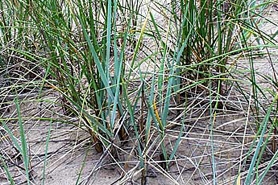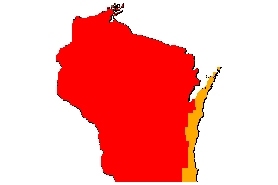Lyme grass or sand ryegrass
(Leymus arenarius or Elymus arenarius)
An invasive grass in coastal regions. Its form of fast vegetative growth can negatively affect native beach and dune vegetation. As Lake Michigan's water levels have decreased, more areas have been colonized by this species. Stems are smooth, round and stout; the plant is 2-4' tall.
Classification in Wisconsin: Prohibited/Restricted (Restricted in Door, Kenosha, Kewaunee, Manitowoc, Milwaukee, Ozaukee, Racine and Sheboygan counties; Prohibited elsewhere).
- Ecological Threat
-
- It can grow in various habitats but is especially concerning on the shores of the Great Lakes. With a spreading root system, lyme grass can stabilize our naturally shifting dunes and compete with rare grasses.
- Occupies the same dune habitat and poses a threat to several native rare plants which include: Elytrigia dasystachya, Calamovilfa longifolia, Salix cordata, Cirsium pitcheri, Solidago simplex, Cakile lacustris, Euphorbia polygonifolia.
- Identification
-
Leaves: Broad, rigid, straight, with a short ligule; blueish in color. 12" long and 0.5" wide.
Flowers: Dense spikes with three flowered spikelets; glumes are not longer than the spikelets. Flowers in July. Points are blue-green in early summer and turn beige later in the season.
Roots: Rhizomes.
Similar species: American dune grass (Ammophila breviligulata Fernald) has green leaves and is less robust. Thick-spike wheatgrass (Elymus lanceolatus) is identical in size and color but has a spike thickness of 5-10 mm compared to lyme grass with a spike thickness of 15-25 mm. There are more characteristics within the inflorescence that can help discern the two species and others; however, please refer to a regional biologist for identification.
- Control
-
Mechanical: Not recommended control.
Chemical: Foliar treat stems with Habitat (Imazapyr) herbicide mixed with Tactic surfactant at a rate of 1.5 ounces of each product per gallon of water. Applications may be made in early June through October if the leaves are still green. Several applications may be needed.
- Resources
- Sources for content:
- Horwood, A.R. British Wildflowers In Their Natural Haunts. Vol 2-4. Chest of Books [exit DNR] Online Resource.
- Cofrin Center for Biodiversity. University of Wisconsin - Green Bay Herbarium. Invasive Plants of Wisconsin. Leymus arenarius [exit DNR].



